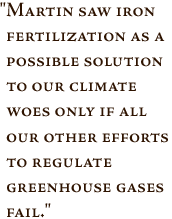

|
As is often the case with great scientific ideas, Martin’s iron hypothesis met with every reaction but complacency. Some believed his bottle experiments were not accurate representations of marine conditions as they did not contain those zooplankton that fed on the phytoplankton. Some scientists couldn’t see how a simple trace metal such as iron could possibly affect aquatic life so profoundly. On the other hand, many large commercial interests and governments now embrace Martin’s hypothesis. They view iron fertilization as a way to remove carbon dioxide from the air and bring themselves within compliance of the proposed Kyoto Protocol. The idea is that the carbon drawn down by the iron fertilization could offset excess emissions from coal-burning power plants and other carbon sources. By drawing down enough carbon, they believe they can trade “carbon credits” under the Kyoto Protocol and avoid costly renovations to plants and factories. Nearly all scientists are concerned that if private companies or governments use Martin’s research for wholesale fertilization of the HNLC zones, disaster could ensue. Poisonous algae blooms could be created, methane—a greenhouse gas 30 times more potent than carbon dioxide—could be released, and entire aquatic ecosystems could be thrown out of whack. A more timid researcher may have shut himself in a lab and refused to answer phone calls. Martin, however, accepted this controversy willingly. He endured the media onslaught and even claimed on more than one occasion that we may be able to reverse the warming effects of greenhouse gases by littering the ocean with iron. At the same time, he emphasized to those overzealous about the idea that further tests would have to be performed before we start dumping iron into the oceans. The people who were close to him knew Martin was a scientist at the end of each day. Coale explains that while Martin was a bold thinker, he saw iron fertilization as a possible solution to our climate woes only if all our other efforts to regulate greenhouse gases fail. “I think he brought this out in the open to bring attention to the work at Moss Landing and to the oceanographic community as a whole,” says Penny Chisholm, a friend of Martin’s and an oceanographer at the Massachusetts Institute of Technology. Marlene Martin said his greatest concern was that his findings would be misused. John Martin planned on following up these initial tests by fertilizing a small patch of HNLC ocean in the central pacific near the Galapagos Islands. If the phytoplankton populations shot up with the addition of iron, then his hypothesis would be proven correct. In 1991, however, Martin began having back pains. Medical tests revealed he had prostate cancer that had spread into other parts of his body. For the next two years he underwent chemotherapy and radiation treatments. His colleagues and friends did not want to see him or his work die. They especially didn’t want to allow those naysayers who doubted his work to get the final word. Marlene Martin says that his friends, family, and colleagues were around him constantly during his final weeks in the hospital. They’d stay with him throughout the day, sometimes spending the night on a cot in his room. John Martin died on June 18, 1993. After his death the scientists at Moss Landing followed his vision tirelessly. “We immediately stepped into the leadership position when he left,” says Coale. Dick Barber of Duke University and Kenneth Coale and Ken Johnson at Moss Landing carried out Martin’s first campaign, known as “Ironex I.” For this experiment the scientists dumped a truckload (445 kg) of iron over a 64-square-kilometer patch of clear, blue, nearly phytoplankton-free ocean near the Galapagos Islands. The experiment was a success in that phytoplankton levels increased threefold. Kenneth Coale launched Ironex II in 1995 and corrected for a few problems found in the first experiment. This time the researchers sprinkled an area roughly the same size as the first with iron several times over three days. The phytoplankton populations bloomed so rapidly that the researchers claimed they could smell it growing. The iron increased phytoplankton levels to 30 times greater than normal, producing essentially the same biomass as 100 redwood trees, and the phytoplankton drew down more than 2,500 tons of carbon. These results changed the field of oceanography forever and vindicated Martin. But, as Coale explains, Martin’s work goes beyond his iron hypothesis. “He showed that no longer is life in the ocean determined solely by the standard nutrients, but minute trace metals are involved too,” says Coale. This knowledge could have far reaching consequences for oceanography that go well beyond the iron hypothesis. But in the end, perhaps Martin didn’t give as much importance to his own iron hypothesis as the rest of us. After Martin’s death, a list was found on Martin’s computer wherein he had written what he most wanted to live for. His top three priorities were spending more time with his wife, his two sons, and his dog. After that he wanted to finish rebuilding a lab that was destroyed in the 1989 earthquake. “Proving the iron hypothesis was sixth or seventh. Certainly not at the top of the list,” says Marlene Martin. next: References
|
 On the Shoulders of Giants
The results of the Southern Ocean Iron Enrichment Experiment (SOIREE) experiment in 1999 were captured by the Sea-viewing Wide Field-of-view Sensor (SeaWiFS). The bright comma in the above image indicates phytoplankton growth stimulated by iron added during the course of the experiment. (Image courtesy Jim Acker, Goddard Distributed Active Archive Center, the SeaWiFS Project, NASA/Goddard Space Flight Center, and ORBIMAGE | ||